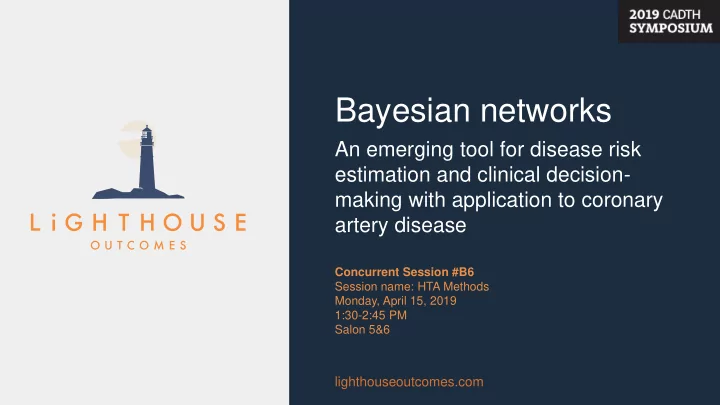

Bayesian networks An emerging tool for disease risk estimation and clinical decision- making with application to coronary artery disease Concurrent Session #B6 Session name: HTA Methods Monday, April 15, 2019 1:30-2:45 PM Salon 5&6 lighthouseoutcomes.com
Disclosure • I have the following relevant financial relationships to disclose: • Employed by Lighthouse Outcomes Inc., Toronto, Ontario, Canada
Challenges Key challenges in HEOR analyses
Key challenges in HEOR analyses • Precision medicine • Right treatment for the right person at the right time • Modelling problems are increasingly becoming complex • Biomarkers, patient characteristics, socio-demographics, genetics, study and treatment factors • Balancing multiple objectives • Maximizing treatment effectiveness, safety and minimizing cost • Accounting for patient preference and expert opinion
Bayesian networks With application to a coronary artery disease dataset
Bayesian network • Probabilistic graphical models P(A,B,C,D,E) = P(A) P(B|A) P(C) P(D|B,C) P(E|D) • Useful for transparent reasoning under uncertainty • Flexible – fit to data or problem • Can combine data-driven computational methods with expert input and background knowledge
Step 1 – Structure learning • Methods for learning structure of Bayesian network • Machine learning • Maximize model likelihood penalized by model complexity • Perform conditional independence tests • Expert elicitation Edge directions do not imply cause-and-effect relationships Koller, D., Friedman, N., & Bach, F. (2009). Probabilistic graphical models: principles and techniques. MIT press.
Step 2 – Parameter estimation • Represent the conditional probability tables (i.e. probabilities of a node given values of its “parents”) • Maximum likelihood-based methods + Data
Z-Alizadehsani dataset • Publicly available dataset from UCI ML repository 1,2 • Contains records of 303 visitors to cardiovascular research center in Iran • 55 predictors: • Demographic • Symptoms • ECG results • Biomarkers/lab measures • Coronary artery disease (CAD) is the outcome of interest • Result of angiography 1 Alizadehsani, R., Habibi, J., Hosseini, M. J., Mashayekhi, H., Boghrati, R., Ghandeharioun, A., ... & Sani, Z. A. (2013). A data mining approach for diagnosis of coronary artery disease. Computer methods and programs in biomedicine, 111(1), 52-61. 2 Alizadehsani, R., Habibi, J., Bahadorian, B., Mashayekhi, H., Ghandeharioun, A., Boghrati, R., & Sani, Z. A. (2012). Diagnosis of coronary arteries stenosis using data mining. Journal of medical signals and sensors, 2(3), 153.
CAD Bayesian network Legend Outcome Demographic Biomarkers/lab measures ECG measurements Symptoms Unconnected nodes (independent) are not shown for simplicity
Network parameters (example) Legend Outcome Demographic Biomarkers/lab measures ECG measurements Symptoms
Network parameters (example) Legend Outcome Demographic Biomarkers/lab measures ECG measurements Symptoms Probability of CAD Values of parent nodes
Markov blanket of CAD Legend The Markov blanket of CAD Outcome Demographic contains variables that Biomarkers/lab measures summarize all information ECG measurements about CAD Symptoms
Marginal probability of variables
Personalized probability update Observed in clinic for patient X
Prognostic values (PV) Demographics Biomarkers/lab measures ECG measurements Prognostic value (max value = 1.0) Symptoms PV of zero represents uninformative Variables (ordered by median PV) Cover, T. M., & Thomas, J. A. (2012). Elements of information theory . John Wiley & Sons.
Classification performance AUC Model type Feature name (Mean ± standard deviation) Simple 0.84 ± 0.10 L2 penalty (ridge 0.92 ± 0.06 regression) Logistic regression L1 penalty (Lasso) 0.92 ± 0.05 Backward selection 0.86 ± 0.11 Edgeless network 0.48 ± 0.13 Bayesian network Naïve Bayes 0.93 ± 0.04 Hill climbing 0.93 ± 0.04
• Ideal responders • Select a patient profile (jointly) based on “most likely” to have CAD Other uses of • Effect modification Bayesian • Backwards reasoning (“diagnostic reasoning”) networks • Find probability that a person with CAD has ventricular hypertrophy • Decision & cost-effectiveness models • Adaptive questionnaires & clinical decision support tools 1,2 1 Seixas, F. L., Zadrozny, B., Laks, J., Conci, A., & Saade, D. C. M. (2014). A Bayesian network decision model for supporting the diagnosis of dementia, Alzheimer ׳ s disease and mild cognitive impairment. Computers in biology and medicine, 51, 140-158. 2 Sesen, M. B., Nicholson, A. E., Banares-Alcantara, R., Kadir, T., & Brady, M. (2013). Bayesian networks for clinical decision support in lung cancer care. PloS one, 8(12), e82349.
Conclusion Key messages
Key messages • Individual risk prediction for personalized medicine • Transparent models • Ability to discover and represent relationships between variables • Incorporation of background knowledge • “Living” models that adapt new data become available
Thank you Primary contacts: agupta@lighthouseoutcomes.com parora@lighthouseoutcomes.com 1 University Avenue. 3 rd Floor info@lighthouseoutcomes.com Toronto, Ontario M5CJ 2P1 Canada +1 800 535 9760 @lighthouseheor
Recommend
More recommend